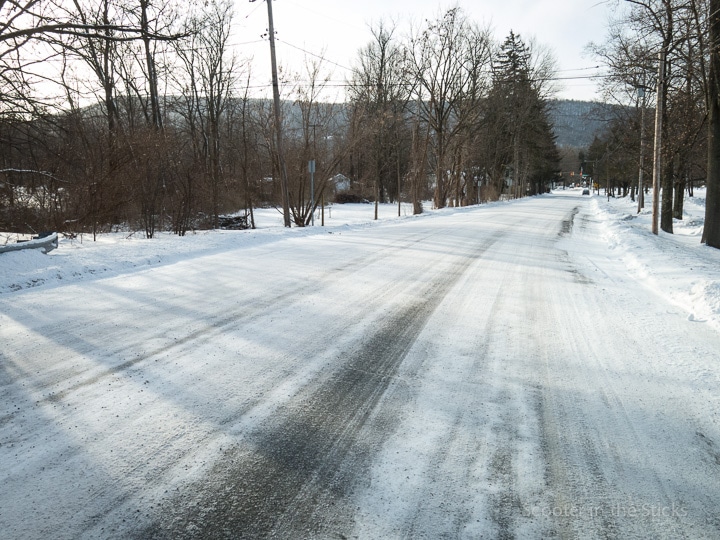 With so much snow and cold weather lately I’ve just not been interested in riding lately. I’ve traversed this sort of surface but I no longer am interested in testing my endurance or skill on the ice. Instead, I’ve been exploring my photographic roots and am spending more time making photographs on film and working in the darkroom. A post on a forum this evening spoke of a “reboot” in life. That may be what I’m doing.
With so much snow and cold weather lately I’ve just not been interested in riding lately. I’ve traversed this sort of surface but I no longer am interested in testing my endurance or skill on the ice. Instead, I’ve been exploring my photographic roots and am spending more time making photographs on film and working in the darkroom. A post on a forum this evening spoke of a “reboot” in life. That may be what I’m doing.
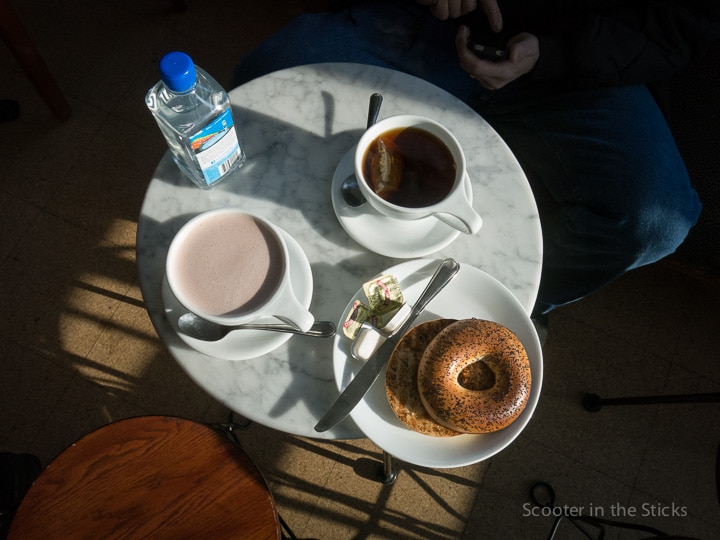 Sunday morning at Saint’s Cafe has been the place to validate my non-professional photographic life with the help and participation of friends on similar quests. Everyone should have a time and place to confirm some things in life. The hot chocolate and bagel is just icing on the experience.
Sunday morning at Saint’s Cafe has been the place to validate my non-professional photographic life with the help and participation of friends on similar quests. Everyone should have a time and place to confirm some things in life. The hot chocolate and bagel is just icing on the experience.
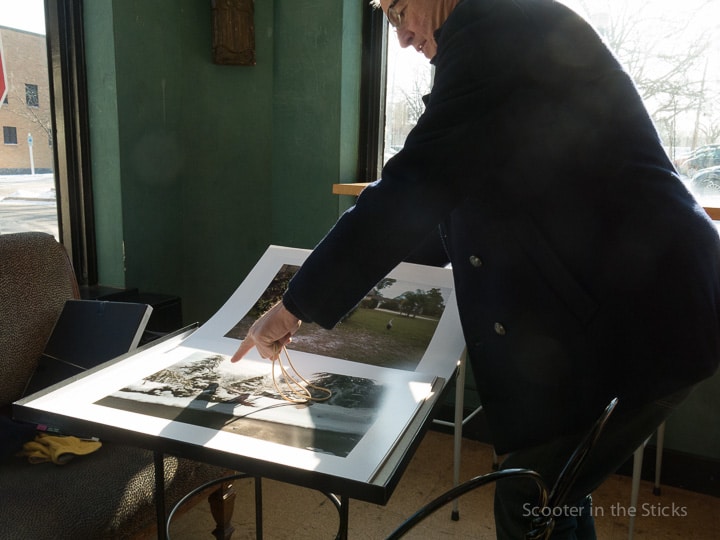 Paul Ruby has been consistently working and producing gallery quality digital prints from scenes from his life. Seeing someone consistently show up with new work, regardless of quality or subject, is inspiring. Everyone is busy with myriad responsibilities and seems to live in chaos so when a person manages to inject some personal creative expression and output into their days is kind of amazing to me.
Paul Ruby has been consistently working and producing gallery quality digital prints from scenes from his life. Seeing someone consistently show up with new work, regardless of quality or subject, is inspiring. Everyone is busy with myriad responsibilities and seems to live in chaos so when a person manages to inject some personal creative expression and output into their days is kind of amazing to me.
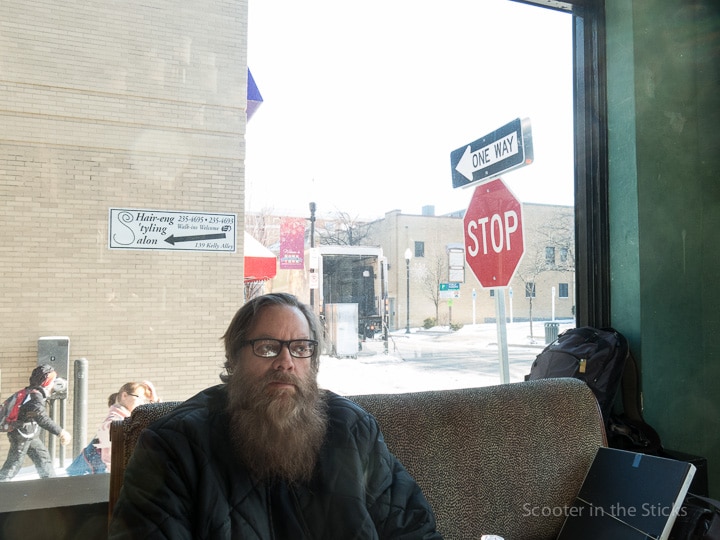 Gordon Harkins has been showing up for years now and most times with new work. In his frustration that he’s not doing more I recognize my own awful critic that can’t see how much I’m actually doing myself. I remind him of the output he’s accomplished but I don’t think he believes it. I’m familiar with the trait.
Gordon Harkins has been showing up for years now and most times with new work. In his frustration that he’s not doing more I recognize my own awful critic that can’t see how much I’m actually doing myself. I remind him of the output he’s accomplished but I don’t think he believes it. I’m familiar with the trait.
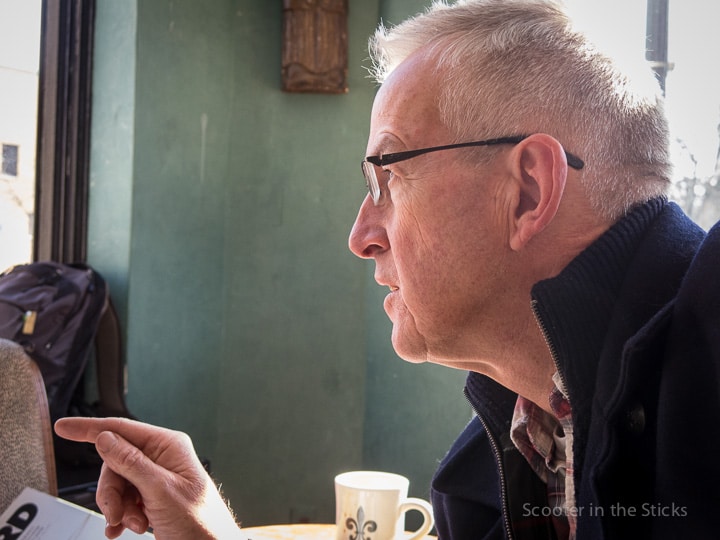 Photography is important to Ruby and his thoughts, words and gestures support that observation. I often sit back just to watch and listen to the show.
Photography is important to Ruby and his thoughts, words and gestures support that observation. I often sit back just to watch and listen to the show.
Each week I continue to try and expose two rolls of film and make three prints. It feels random and unfocused but I trust that it will lead somewhere if I do the work. So here’s the latest from the photographic reboot:
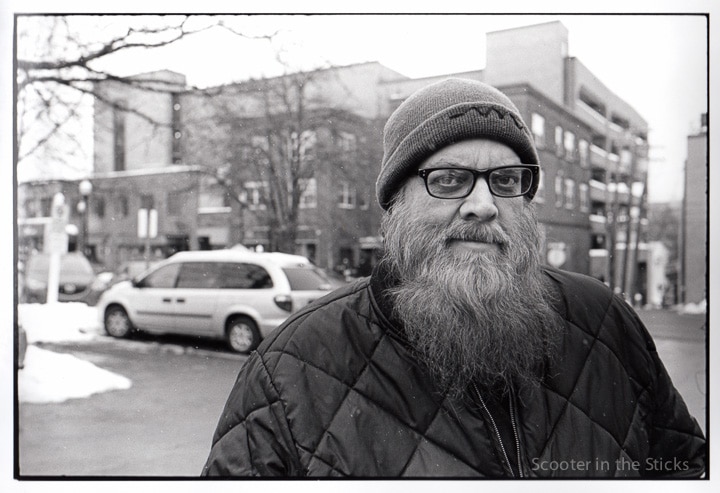 Leica M6 portrait of Gordon Harkins made the previous Sunday as snow began to fall.
Leica M6 portrait of Gordon Harkins made the previous Sunday as snow began to fall.
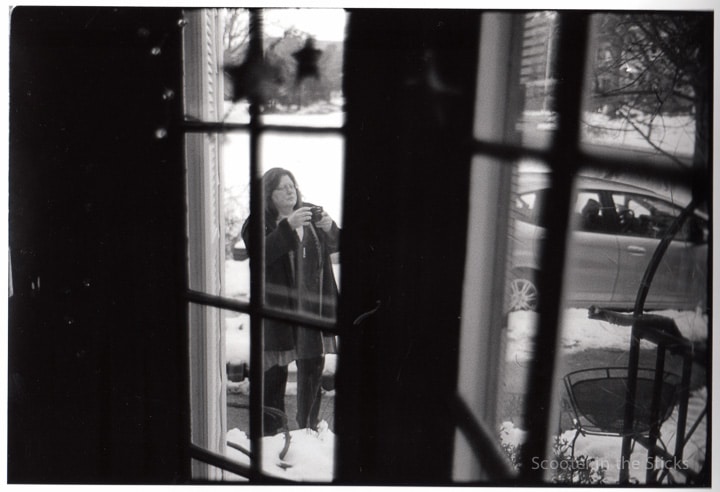 View of Kim making photos of her snow-covered garden.
View of Kim making photos of her snow-covered garden.
 Portrait of my Belgian Sheepdog Junior in the snow.
Portrait of my Belgian Sheepdog Junior in the snow.
So that’s it. Three prints. This week I have the 8×10 Calumet C1 view camera out and have been considering a switch for a bit. The camera is heavy — almost 18 pounds — and the film is expensive — almost $2.50 a shot — so I’m still pondering. Whatever happens, I trust the process to yield something good if I show up to do the work.
Just like riding the Vespa scooter.
Hey Steve. I seem to be around many including myself who are also rebooting. Nice post.
Brent
I can’t help but think that rebooting is age-related — we’re sensing mortality more strongly and a subtle increase in regret…
Really nice pics Steve, I have no knack for photographing people really. The second picture of the tabletop…..the lights and shadows give it an almost 3D feel….very well done.
Thanks Dom for the comments about the pictures. Like every other skill a person can have, practice helps the outcome.
Nice. I may have to dust off the Nikon and do some serious photography again instead of just the snapshot mode that I seem to have fallen into.
There’s a lot of positive things to be said about snapshot mode, at least the part where you become unconcerned with much beyond documenting what’s in front of you. As I carry the Leica around with me I try to stay in snapshot mode. Or maybe it’s “enhanced” snapshot mode.
Thanks for the post Steve. It reminds me of days long by when I used to work with chemicals in my home processing lab. There was something magical about seeing an image appear on what was once a sheet of white paper. I still have a film camera but alas it sits in a display cabinet with other photographic memorabilia.
Thanks for the memories.
Sometimes film cameras are best left in the display case don’t you think? For each photographer the needs and goals are different. Same with riding. The right tool for the right job as determined by the user.
NSR: Steve, I am taking the National Geographic photography course (excellent!) in which the instructor talks about the “iconic” photograph — the image that somehow transcends its subject matter so that it includes that special “something” which infuses it with feeling and makes it art, not just “a photo”. Your post inspires a question in this regard: is it better to wait for the conditions or the moment to be right, and attempt to capture that “iconic” photo right then and there; or is it better to take lots of photos and hope that somehow, in that process, you get lucky enough to capture the “iconic” photo in that process? You’re a much better photographer than I, and I would be grateful for your thoughts in this regard. Thanks!
I guess my reaction to the notion of waiting for the “iconic” photo is this: We don’t always recognize it at the time. At least I don’t. I’m certain that I’ve dismissed shooting pictures because the “light is wrong” when in fact it is amazing as evidenced by a photograph that Kim has made at that moment which I see later.
In my experience it is best to shoot and consider the results later. The only caveat I’ll make relates to my work with a large format camera where the cost of tripping the shutter is high. So I am a bit more careful in that situation. But I don’t accept the Ansel Adams myth about waiting for the perfect moment. That may work for landscapes but not much else. The same with Henri Cartier-Bresson’s “decisive moment”. I believe the moment exists but you can’t wait for it, just work and hope to be ready when it comes. When you look at Cartier-Bresson’s contact sheets it’s obvious he shot a lot of moments that weren’t decisive.
Are you taking one of online National Geographic photo courses from the Great Courses Company?
Yes, exactly right, the National Geographic Introduction to Photography from the Great Courses. Seems to be really excellent! I have had a workshop weekend from Rocky Mountain School of Photography (also excellent!) but still consider myself a relative beginner. I admire the photos in your blog and hope to aspire to that level of achievement someday.
First question is, are the sample prints done by wet process or are they printed on a wide carriage ink-ject/laser printer?
And if you use that Calumet camera by what means shall be able to process those sheets of film?
Keep in mind three prints or three results if you wish are going to take one heck of a lot longer using sheet film and the related processes.
I applaud your efforts however keep in mind the process takes TIME, do you have the time?
Shall be watching, and waiting.
The prints are wet process gelatin silver prints. Ilford Multigrade fiber paper, 11×14 processed in Kodak Dektol developer mixed 1:2. Acetic acid stop bath and fixer from the Photographer’s Formulary. Prints are washed and processed with Hypo clear to make them more permanent.
I consider the prints proofs because I don’t do much with them. My negatives are consistent enough that I can print almost everything at the same contrast and exposure time. This keeps the darkroom time for printing each week under two hours. Film processing is under an hour.
You’re right about the view camera taking longer. When I use it I’ll hope to expose, process and print three negatives. Can’t do a lot more without ending up in the poor house.
I process the 8×10 film in BTZS developing tubes. I’ve only used them to date with 4×5 but I expect they’ll work as well with 8×10. I used to do the processing in a tray with bare hands and then gloves. Don’t need to be pushing my hands in chemicals anymore.
I believe that each of us needs regular reminders that creative magic might occur only if we are doing the work. It is guaranteed not to occur if we are not putting in the time. Life seems to be solely about engagement, which certainly does not mean rushing about madly every waking moment, but about being as aware as possible, of one’s surroundings and (if) of the others that people that space and of the activity therein. (I’m sorry, this is beginning to sound a bit cliche.)
It’s just that I’ve believed for a long time that if I cease to engage with life, I risk simply evaporating. Life cannot be experienced passively. In fact, I don’t believe that it would tolerate passivity for very long.
Thanks, as always, for sharing your lovely photographs. I’ve really been enjoying the recent black and white trend in your posts.
I agree with your ideas about engagement and life. And I believe people do begin to evaporate when they cease to engage and grow passive. You see their remains on couches and easy chairs. It’s probably what keeps me from retiring.
Hopefully there will be more black & white photos to come!
Steve, you have a knack for seeing the realness in the people around you. Love the candidness of the last portrait of Paul and the B&W of Gordon.
Thanks for the kind words about the portraits. I like photographing people but don’t do it much. It takes a great effort to approach strangers. Paul and Gordon are easy, available, willing targets!
Hi Steve.
That color portrait of your fantastic bearded friend is quite funny: all that hair, and on the back a STOP sign and another which seems to direct him back to a hairdresser 🙂
I couldn’t hold back a laugh!
True street photography 😉